Tracksuits and Tan walkers: Wealth, ambition and Melbourne’s Lululemon elite
New money follows old money, and money – lots and lots of money – has been in the first suburb south of the Yarra for a long time.
By Liam Mannix
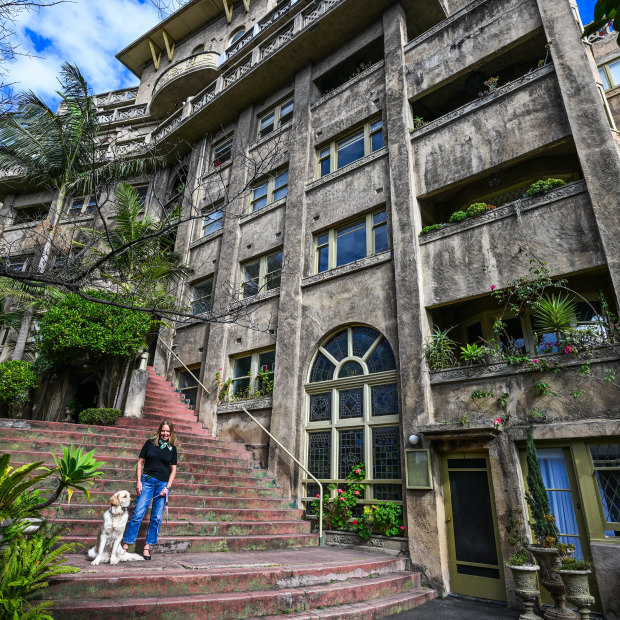
Heather Nette King with her dog, Sunday, out front of Beverley Hills.Credit: Joe Armao
In the court of the Queen of South Yarra, one is greeted with a flute of Laurent-Perrier, a wedge of famous carrot cake, and – if one is in good favour – a “love you, darling”.
Did I say Queen? “Empress, darling,” purrs Heidi, owner and proprietor of 179 Domain Food and Wine.
Domain Road, where the empress holds court, groans under the weight of old money, and she knows every millionaire.
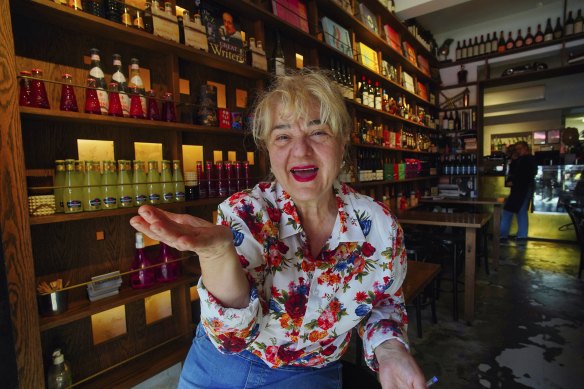
Heidi, the empress of South Yarra, and proprietor of 179 Cafe.Credit: Luis Enrique Ascui
“Solly Lew, Mrs Lew, the new one, the old one, all the in-betweens, the exes,” she says with a laugh.
The Pratts. Oh, and the footballers! “He’ll say, ‘Hi, I’m Nathan’. And I’ll say, ‘Hi, I’m Heidi’. I don’t know?”
So it goes in South Yarra, which is among Melbourne’s most glitzy postcodes.
“Anyone who is anyone is here,” says Heidi, who – in true South Yarra style – asks us not to reveal her surname.
“Anyone who was anyone is still here. And anyone that will be anyone is down there at the school. She waves a hand down Domain Road, toward Melbourne Grammar, where tuition runs up to $46,540 a year.
Any film starring “the British Dames” – Helen Mirren or Judi Dench – will reliably receive positive reviews from the local set, says Benjamin Zeccola, CEO of Palace Cinemas, which operates Cinema Como on the corner of Toorak and Chapel. An action movie might draw a sniffed, “People who lack intelligence will enjoy it.”
Lest you forget where you are, the window-shaking buzz from Lindsay Fox’s chopper as he lands on Melbourne High School’s oval will remind you of your status in life. In true billionaire style, he does not pay a cent for the privilege. So it goes in South Yarra.
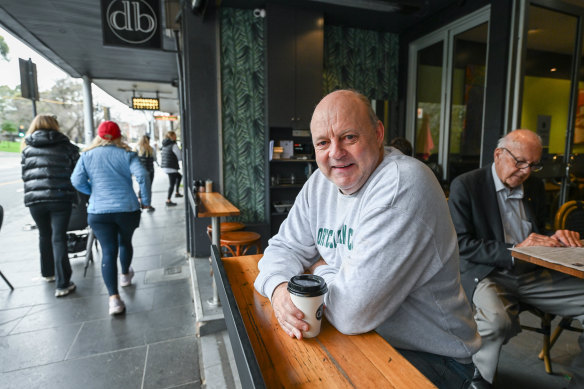
Billy Brownless drinks coffee at Domain BrasserieCredit: Joe Armao
I spot Geelong legend and media personality Billy Brownless sipping a large cappuccino at Domain Brasserie, where he shares space with several women who are themselves sharing chair-space with small curly haired dogs.
Brownless moved to Park Street two years ago, attracted by the suburb’s centrality. “There’s that many eateries there, take your pick. Movie theatre, pubs, nightlife, what more do you want?” He loves it here, but admits to still finding it a funny fit.
“When the sun comes out you get everyone who owns Lululemon activewear walking around the Tan and Fawkner Park,” he tells me later over the phone. “They have all got a dog too. You can’t walk down the street if you just have an old Adidas tracksuit, you’d feel out of it.” Brownless confirms that he is indeed wearing an old Adidas tracksuit as we speak.
The suburb’s triangulation between three of Melbourne’s most-expensive schools – Grammar in the north, Wesley College down south and Geelong Grammar’s Toorak campus to the east – means people pay attention not just to wealth but to the intergenerational transfer of that wealth.
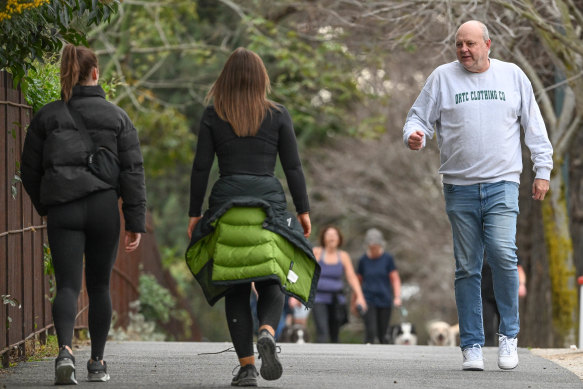
Billy Brownless strides out along the Tan among the activewear set.Credit: Joe Armao
“Being situated amongst some of the most prestigious private schools, you’ve always got another generation – if you’re doing the right thing by the community,” says Rabih Yanni, owner and publican at the Botanical Hotel, or “the Bot” to locals.
Playing nice with the young scions is one trick for surviving here. The other: don’t get caught up in it.
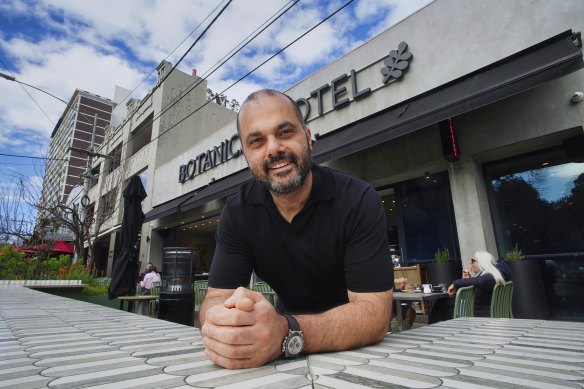
Rabih Yanni, owner and publican at the Botanical Hotel.Credit: Luis Enrique Ascui
Domain Road is “the bubble within the bubble of South Yarra”, says Yanni.
“There’s this beautiful shiny aesthetic ... there’s a certain image that’s expected, of how you behave.” After all, he says, “it’s 3141”.
Later, I ask haute couture designer Alin Le’ Kal, who has a shopfront on Toorak Road, to imagine the suburb as a person.
“I’d see her working in fashion or TV: a goal-getter. Strong personality,” he says.
“I always say South Yarra is a Scorpio: very strong, dominant.
“Everyone is either caught up in well-to-do families or working extremely hard to be where they are – because South Yarra is not cheap.”
Verdant hills
South Yarra’s history takes in both extraordinary wealth and ambition to match, all underpinned by geography.
Before white settlement, South Yarra – covered in tea tree scrub and swamp – was part of the hunting grounds of the traditional owners of the land, the Wurundjeri Woi-wurrung and Bunurong people. After settlement, an Aboriginal mission to provide for the “civilisation” of the local Indigenous people was located on the south side of the river. The mission eventually closed as the land became more valuable in the late 1830s.
The suburb’s dominant feature is the verdant hills of the Royal Botanic Gardens. When Government House opened there in 1876, it put the suburb among the city’s most-desirable for the nouveau riche of Melbourne’s gold rush.
Grandiose mansions would soon squat across the slopes south of the Yarra. The grandest manse of all, Como House, was erected in 1847 from stones and mud hauled up the banks of the river under orders from Edward Eyre Williams, a lawyer and later judge of the first Supreme Court of Victoria. The construction was part-funded with compensation Williams won for the loss of his “property” after the abolition of slavery.
But new money hungers to follow old. Como was soon purchased by Frederick Dalgety, newly rich from the gold rush, and then by John Brown, a merchant who – like many who come to South Yarra – had ambitions of joining the city’s elite.
Brown overextended himself and lost his fortune, including Como, which was sold to one of Melbourne’s wealthiest pastoralists, Charles Armytage, as his family’s social home in Melbourne. The family would hold the property for almost 100 years.
By that time, many of the grand piles neighbouring Como now found they were rubbing shoulders with a new way of living: apartment blocks.
As land values shot up and housing became scarce after WWII, it became financially sensible to sell a slice of the vast landholdings to developers, who quickly bulldozed and erected new apartment complexes.
“Apparently the South Yarra set were quite aghast: ‘Oh, it’s going to end up like Sydney’,” says interiors stylist and writer Heather Nette King, who has lived in the suburb for six years.
The fall of many grand mansions allowed a new, aspirational generation – and a new architecture. Many young architects got their start in South Yarra, where they were free to experiment with a new forms and styles. The suburb has “some of the best 20th century architecture you’ll find in Melbourne”, says architecture and design writer Stephen Crafti, another local.
“They are really quite groovy. They are well-built, spacious. When people bag the ’70s brown brick walk-ups, I think they are lovely, compared to some of the boxes we are seeing built today.”
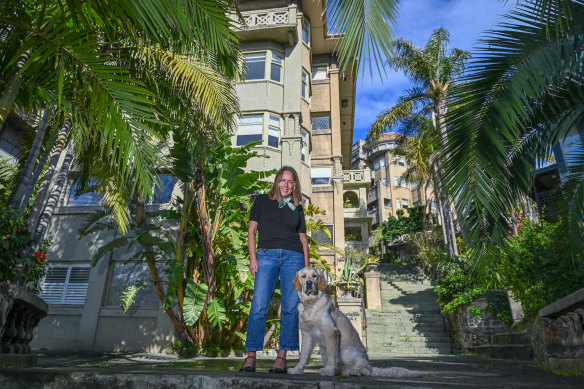
Heather Nette King with her dog, Sunday, out front of Beverley Hills.Credit: Joe Armao
Beverley Hills, where Nette King lives, tells the suburb’s story. Designed by Howard Lawson in 1935 and built using bricks and stained-glass recycled from those bulldozed mansions, it brought a touch of Hollywood to the suburb.
Lawson built in a grotto, waterfall, sprawling gardens, two rooftop terraces and 44 apartments in Hollywood Spanish mansion eclectic style. The first apartment complex pool in Melbourne soon became prime sunbathing territory for various Sale of the Century models.
Allegedly. “You never know what to believe”, says Nette King.
The stylists, actors, dancers, swimmers and architects that called the place home threw lavish bashes, surely much to the horror of their old-money neighbours.
An artisan with aspirations needs a patron who can fund them, thus South Yarra soon became a suburb of fine food and finer fashions.
Fine dining emerged in the 1960s in – where else – Toorak Road, where Maxim’s offered a “touch of Toulouse Lautrec”. The French fine-dining legacy lives on at suburban icon France-Soir in Toorak Road – “where you go if you want to get treated with absolute contempt”, one local says.
South Yarra enjoyed a second flourishing in the early ’90s as Australian fashion and design enjoyed a sudden global boom. Local designers – Alannah Hill, Kookai, Bettina Liano – were among the biggest names along the strip. Chapel Street became a global draw for the best talent. Hill, who was born in Tasmania, recalls being dumped by a taxi in Chapel Street, six suitcases of costumes coming tumbling out with her.
The influx of talent, combined with a suburb full of wealthy patrons, had a kind of alchemical effect on Chapel Street, says Sener Besim, an internationally renowned designer who has a long association with the street. There was a buzz, “an energy, it just felt a little more creative and progressive”.
“Everyone in Sydney wanted to be in Chapel Street.”
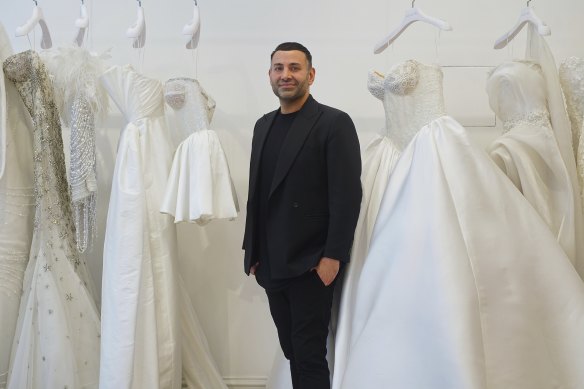
Alin Le’ Kal at his atelier.Credit: Luis Enrique Ascui
Le’ Kal would come down Toorak Road while he was still in high school, staring at the beautiful dresses through the windows. His atelier now sits near the corner of Chapel Street and Toorak Road, an intersection that remains dense with fashion: Country Road’s flagship is on one corner and Scanlan Theodore just relocated to the imposing Capitol Grand development.
But over time, Chadstone Shopping Centre managed to lure away many of the biggest names. That, combined with booming rents, has left fashion in retreat. Le’ Kal’s boutique is now joined by fast-food restaurants.
Chap Laps
Few suburbs can retain their cultural panache forever. Consider Preston. Less than a decade ago, Courtney Barnett was lamenting having to cross the latte line and move out there; now it has several coffee roasters and breweries and is infected with hipsters.
And there’s no doubt Melbourne’s cultural foci have swung north since South Yarra’s heyday. One young woman tells me she finds it hard to get her friends to venture “down south”.
“Most of it’s just northside, the partying now,” she says. The area has developed a “very corporate vibe” just as those across the Yarra have decided it is cool to “cos-play as poor”.
“But it is cooler over there, don’t get me wrong,” she says.
Nette King still remembers “prime Chapel Street party days. There was Chasers. And then you’d go to the market afterwards. That was the early Chap Lap days.”
The nighttime economy still exists, of course: Revolver still expels its share of drunken youth at 3am, while Poof Doof remains among the city’s most important gay club nights.
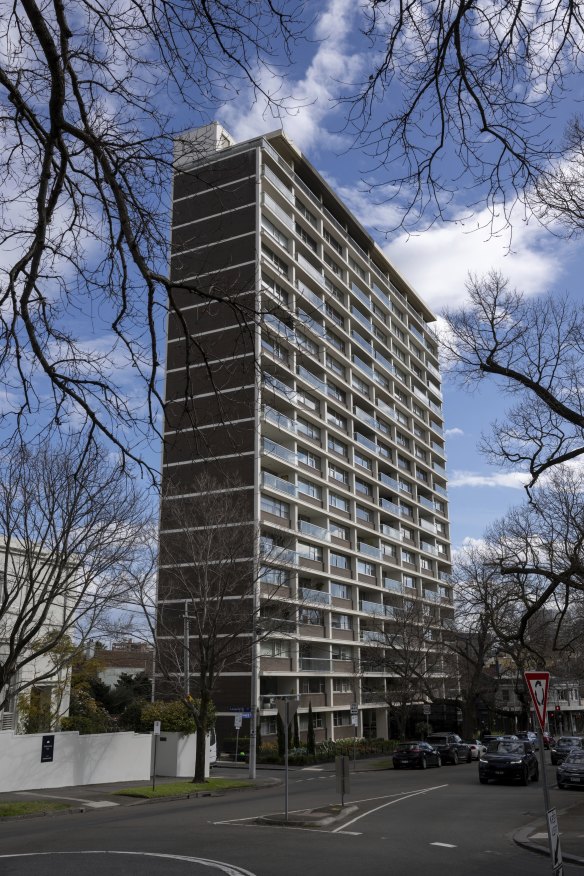
‘The Tower’, designed by Robin Boyd in Domain Road, was one of the suburb’s first apartment blocks.Credit: Penny Stephens
But a change that started with the tearing down of the old mansions is starting to reach critical mass, with transformative effect. Instead of being a destination suburb for shopping or clubbing, a place to be seen, it has become a destination suburb for “aspirational” living.
“There’s renters. That’s people aspiring to live in the area – and one day they will,” says the Botanical Hotel’s Yanni.
Melbourne High has borne witness to those changes. When the red-brick castle was first erected in 1927, “there was absolutely nothing here, just paddocks”, says Dr Tony Mordini, the school’s principal. Now it’s shoulder-to-shoulder with apartment towers.
The school offers public education to any boy clever enough to pass its entrance exam. Perhaps 70 per cent of the current class are children of first-generation migrants, says Mordini.
“The kids don’t come from wealth. But because they are such capable young people, many of them move into a different socio-economic group, and they buy a property in the area.”
The suburb’s housing stock has surged in the past two decades. Thickets of apartments now box in the main shopping strips, topped by a luxury 50-storey high rise at the corner of Toorak and Chapel.
Stonnington Council has ambitions to grow that number even further, says Mayor Joe Gianfriddo. He is enthused by Gurner’s $1.5 billion redevelopment plan for the Jam Factory, which will bring in another few hundred apartments. Rather than outwards, the suburb is starting to look inwards: how can it turn locals into local shoppers?
The pandemic lockdown “maybe benefited us”, Gianfriddo posits, by encouraging people to work from home – and learn to love their suburb.
Others link the increased density of the area to its decline as a destination. “The apartments, the developments in and around Chapel, I’m not sure if they have been of a standard to warrant a really great, well-heeled customer that maybe High Street, Armadale, has,” says Besim.
Chapel Street itself has taken on a north-south character, with luxury shopping close to the Yarra’s banks. As you head south toward Prahran, “it starts to become a bit like Fitzroy,” says Le’ Kal.
The mayor admits there is work to do. “[Chapel Street] was iconic. Will we ever get there again? Because at the moment there are some very problematic sections of Chapel Street around antisocial behaviour, mental health issues, drug and alcohol abuse.”
So it goes in South Yarra.
Start the day with a summary of the day’s most important and interesting stories, analysis and insights. Sign up for our Morning Edition newsletter.
clarification
This article has been updated to clarify that Melbourne High School is a school for boys.